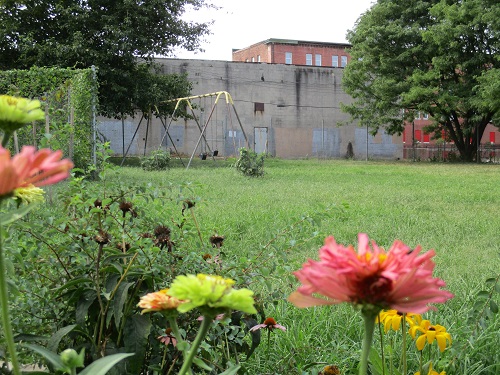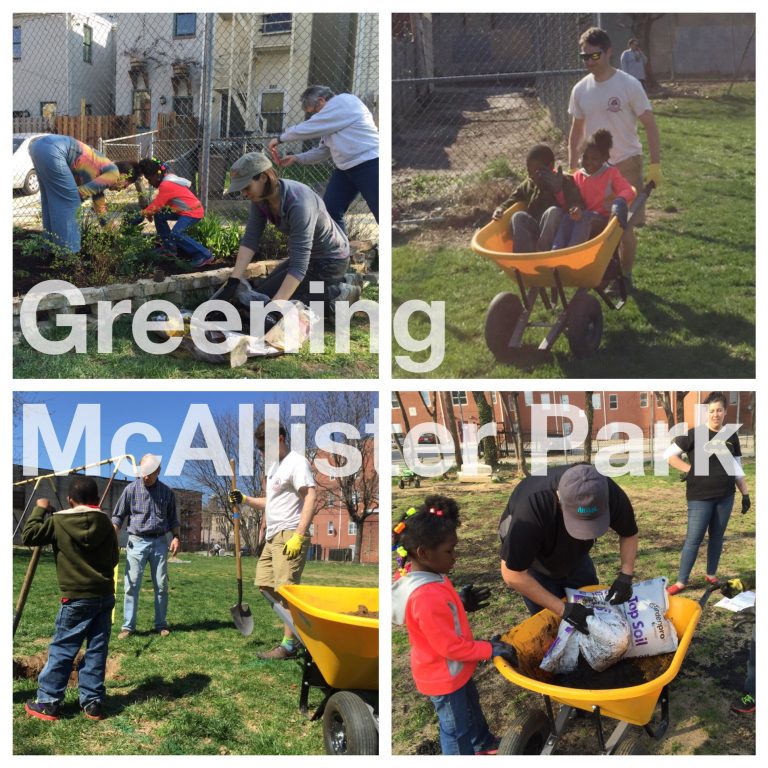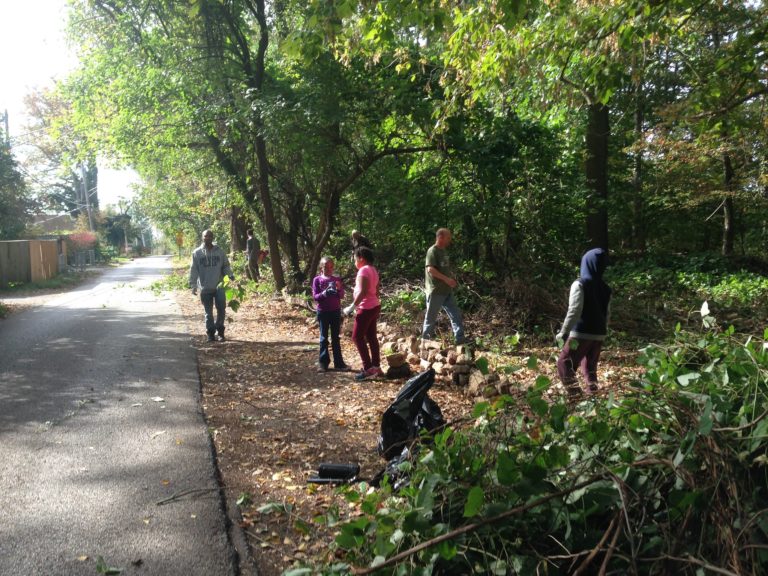
They say you don’t appreciate what you’ve got until you lose it – but the residents of Baltimore’s Greenmount West neighborhood are doing their best to stay ahead of the game. McAllister Park steward Cory Adcock-Camp and her neighbors have asked Baltimore Green Space to preserve their fenced-in grassy park where children play and people walk their dogs. What’s new for Baltimore Green Space is that the park includes a swing-set. We’ve never preserved land with play equipment – this site is making the case for it.
The park is tucked away between two alleys. In the past that gave drug dealers privacy to conduct their business. The sagging fence was covered in ivy, and people would form a long line in the alley to buy drugs through holes in the fence. Now that residents have removed the vines and repaired the fence, the tucked-away location gives children safety to run and play without worrying about getting hit by cars. They also help to plant the trees and flowers that are making the park more beautiful. Dog owners bring their four-legged friends to play, and so the dogs and owners get to know each other. Through the presence and energy of dedicated residents young and old, the activity in the park has transformed into healthier recreation.
Now more than 100 people who live in the neighborhood regularly use the park. Their names form a long line down the page on a petition to preserve the park. The residents worry because the park is located in the Station North Arts District, which is becoming an attractive place for investment. Former park steward Bill Clewell looks uneasily toward the vacant building at the east edge of the park and says that it’s not hard to imagine an investor offering to take the property off the city’s hands and turn it into housing, on condition that the park be part of the package, to be paved over for parking. This is prime real estate in the making.
For Baltimore Green Space, preservation of McAllister Park would be a first: our first site with a swing set. This brings up new liability questions and financial concerns. Most community gardens and similar open spaces were built by residents and can be maintained by residents. A swing set, however, will have occasional maintenance and replacement needs that are beyond the ability of most neighborhoods. Baltimore Green Space will need a plan for how to best address these concerns, and we are working to find a form of protection that will allow us to help neighborhoods with community-managed play spaces.
While Cory and other invested neighbors wait for BGS to go through its approval process and come up with a good preservation process, she and her community continue caring for and enjoying the park. Cory has been watering the grass with water from her own house, but it hasn’t been enough. Her next big plan is to install an irrigation system with a PVC sprinkler line so that the grass will grow better. In addition, Cory is watching the progress at a nearby community park that will be developed in the next two years. McAllister Park will receive the surplus boulders and granite slabs from that location to be used for additional seating and landscaping.
Want to help us preserve sites like McAllister Park? Donate today!

“I’m grateful that we put racial equity front and center in the plan. The damage done by systemic racism is achingly obvious throughout our city. The commission was unwilling to allow race to be the elephant in the room. We want to talk about it. We want to understand whether city agencies and nonprofits are able to effectively counter racism. And we want to create accountability by talking about equity consistently. We found knowledgeable people, including commissioners, to advise on how to weave this in. We will also be learning as we go along.”
“When I looked at our programs in light of the Sustainability Plan, I was pleased to see that our garden and forest programs help meet plan goals such as creating opportunities for residents to increase their connections to nature; building stronger neighborhoods and stronger social connections; and increasing management of our natural systems by residents. And of course – increasing the acreage of maintained and protected land! We know that we’ve got a long way to go to live out our values, but I’m pleased to see where we are.”
Miriam has been working as the co-chair of the Sustainability Commission since 2018. We encourage you to review the plan and do what you can to move it forward in your community. To learn more, check out the Sustainability Plan or visit the Sustainability Open house on April 17.

Be the first to hear about exciting events, news, and opportunities.
[email protected]
(813) 530-8166
2100 Liberty Heights Avenue
Baltimore MD 21217
Facebook | Instagram | Twitter